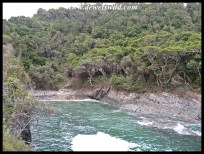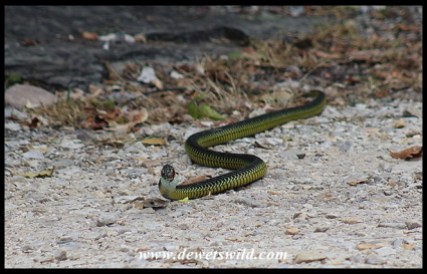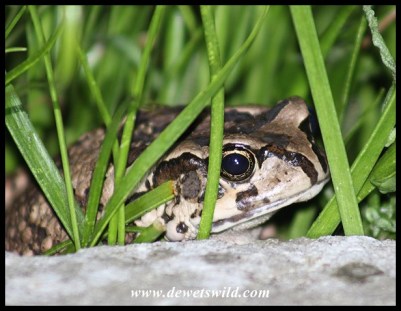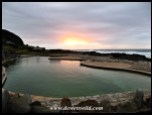When it was proclaimed in 1964, Tsitsikamma was the first marine national park in Africa. Since then it was progressively enlarged as more areas on land and sea was added to the Park, and by the time it was incorporated into the Garden Route National Park alongside Wilderness National Park, Knysna National Lake Area, and extensive tracts of state forests in between in 2009, the Tsitsikamma section covered an 80km stretch of coastline, extending on average 5km out to sea.

The name “Tsitsikamma” is a Khoekhoen word meaning “place of much water”, which is very apt as the region receives on average around 1,200mm of rain annually. This is a rugged but exceptionally beautiful area, with forested slopes, shear cliffs tumbling into the sea, deep ravines cut into the mountains by dark rivers over millennia, and enormous waves pounding unrelentingly onto the rocky shore.
The easy trail leading to the suspension bridges at the river mouth, about a kilometre from Storms River Mouth Rest Camp, the Tsitsikamma’s main tourst facility, really gives the visitor an excellent introduction to the Tsitsikamma-area; bringing you into contact with the beach, ocean, forest and river, and many of the creatures that find a home there.
Notably, Tsitsikamma’s list of recorded mammals is dominated by marine animals rather than the large terrestrial game species normally associated with a national park in Africa. That being said, visitors should count themselves lucky to see one of the seven whale or five dolphin species that ply these waters – we were fortunate to see a pod of Indian Ocean Bottlenose Dolphins in the surf and a handful of Humpback Whales breaching far into the sea. On land however the Chacma Baboons and Rock Dassies are ubiquitous inhabitants of the camp. And with almost 300 bird species recorded, many of which closely associated with the ocean and rocky beaches, the Tsitsikamma section is a birdwatcher’s delight. Most of the Garden Route National Park’s 25 species of snakes are seldomly seen, so we were thrilled to witness an altercation between a deadly venomous Boomslang and Southern Boubou while walking around one morning.
Walking around after dark, and seeing the healthy population of frogs and toads at Storms River Mouth, we realised how grossly inadequate our old guidebook on South Africa’s amphibians was to identify the 24 species that’s been recorded in the Garden Route National Park. We remedied that soon after we got back home!
As already mentioned, Storms River Mouth Rest Camp is the Tsitsikamma section’s main visitors facility and understandably one of the Garden Route’s top attractions. Here, wedged between mountain and sea, overnight visitors have a choice of spectacularly located accommodation and camping sites, serviced by a restaurant and shop that stocks basic food items and curios. There are picnic sites for day visitors and a small swimming beach. Guided boat tours and more adventurous activities up the Storms River gorge can be undertaken daily. Unique snorkeling and scuba trails allow visitors a glimpse into the underwater world of the Tsitsikamma, and on land several walking trails lead deep into the forest. At the eastern side of the Tsitsikamma section lies the more rustic Nature’s Valley Rest Camp, just outside the small holiday town of the same name. The renowned Otter Trail, covering a distance of almost 50km between Storms River Mouth and Nature’s Valley over 5 days, is rated as one of the best and most scenic hiking routes on the planet.
Storms River Mouth was the sixth destination on our December itinerary through eight of South Africa’s national parks. It is easily accessible along a good tarred road that turns off the N2 highway between Plettenberg Bay and Port Elizabeth.





































































Wie het gewen? Slang of voël?
Net so btw… ek velang… 😉
LikeLike
Ek kan my goed indink!
Altwee het redelik ongedeerd van die onderonsie weggestap.
LikeLike
Dis so pragtig daar! Nou verlang ek darem na my kinderdae! Ons het altyd daar in die Tsitsikamma bos vakansie gehou! Dankie vir die pragtige foto’s!
LikeLike
Dankie vir die saam kuier op die tuinroete, Aletta! Dit bly maar n mooi landstreek.
LikeLiked by 1 person
Rugged, beautiful, and filled with wildlife. Another one on my list. Thanks, Dries!
LikeLike
We’re glad to know we’ll soon be welcoming you to sunny South Africa, Hien!
😀
LikeLike
Hello. Wonderful photos as always. I remember the southern boubou and boomslang one from December. My parents took my sister and I on a holiday to Cape Town during the Christmas holidays in December of 1979. We drove there via the OFS, Kimberley, Karoo to Cape Town and back along the south coast Garden Route. We stayed overnight in a small hotel in Wilderness and drove through the Storms River route and continued through the then Transkei back to Durban. I remember the Wilderness and Storms River areas and thinking they were ideal locations for dinosaurs. Your photos bought back that memory and I can still imagine Terranosauros’s and Pteradactyls roaming and flying around the gorges, cliffs, rivers and beaches. The Garden Route landscapes and scenery are truly spectacular!
LikeLike
Wow Kim, I am sure today many of the places you visited then don’t look anything like you remember them. Knysna for instance?
LikeLike
Do you go anywhere in West Africa?
LikeLike
We haven’t yet had the pleasure to visit West Africa, Beth. Does Tsitsikamma remind you of scenes you saw there?
LikeLike
Not at all. West Africa is very poor and not well-kept, but I wonder if there might be places that would be bring relief to the occupants. Serious sicknesses are rampant.
LikeLike
Indeed, Beth.
LikeLike
Beautiful landscapes! And the hanging bridge is extraordinary. I guess, one can rest a lot in this place.
LikeLike
You are absolutely spot-on, Awa. If you really want to get away from the hustle and bustle of your daily routine, then this is the place!
LikeLiked by 1 person
Absolutely amazing wonderful place!! And your photos are really beautiful, and really convey the message that photos are going to make. To me it’s a fabulous place where I could live, there’s everything!😊 I am born in a seaside town and love animals and nature. No, I’m not the least jealous of you!😉😀
LikeLike
Tsitsikamma is a treasure, John. I only wish we lived closer – at around 1200km from Pretoria it is rather difficult, and expensive, to get there regularly. I am glad to know you enjoyed this post so much.
LikeLiked by 1 person
Wow, it´s far away. You really visit every nature place in your country, who is so big. Your blog is my favorite blog, and sure many others as well! Here is everything, good storys, facts and wonderful pictures!😊
LikeLike
You are very kind and generous, John – thank you!
LikeLiked by 1 person
There’s quite a variety of both land types and animals but they’re all beautiful.
janet
LikeLike
Tsitsikamma is a very special place for sure!
LikeLike
Wow! Impressive! You got me looking for Daisies again! lol.. Almost missed that green bird also, you must have good eyes to have seen it in the first place! 🙂
LikeLike
Thanks Teresa! No use looking for daisies when dassies are about – they’ll gobble the flowers up very quickly! 😀
LikeLike
Two questions: Who won the deadly battle? Is that a dassie next to the sign in your first photo? It looks cute.
LikeLike
Spot on , Lois – the little one next to the plaque is a dassie!
And both the boomslang and the boubou walked away from the fight (well, one slithered and one flew) which ended when the bird was satisfied that the snake wasn’t a threat any longer
LikeLiked by 1 person
whew! I know about the food chain but, gosh, I don’t want anyone hurt…or eaten!
LikeLiked by 1 person
what a wonderful place and the pink flower steals the show in that first collage – and the little critter near the sign in the opening photo is so cute…
LikeLiked by 1 person
This really is one of our country’s must-see destinations. Isolated and unspoilt. The little guy next to the plaque is a dassie, and they are even more cute in real life!
LikeLiked by 1 person
oh so is dassie a statue?
LikeLike
Oh no, that little one was quite alive! I meant they are even more cute in real life than static on a photo 😉
LikeLiked by 1 person
ahhhhh – I get it – and what a tease!
and such a dense post – might have another looksee now –
🙂
have a good day
LikeLike
Very beautiful. Nice captures.
LikeLike
Thank you for the very kind comment!
LikeLike
My what a gorgeous place that is! Another one I would love to explore!
LikeLike
The Tsitsikamma really should be on everyone’s itinerary when they visit South Africa; it is a place not to be missed!
LikeLike